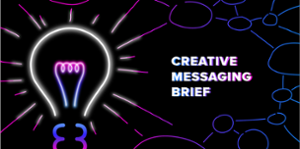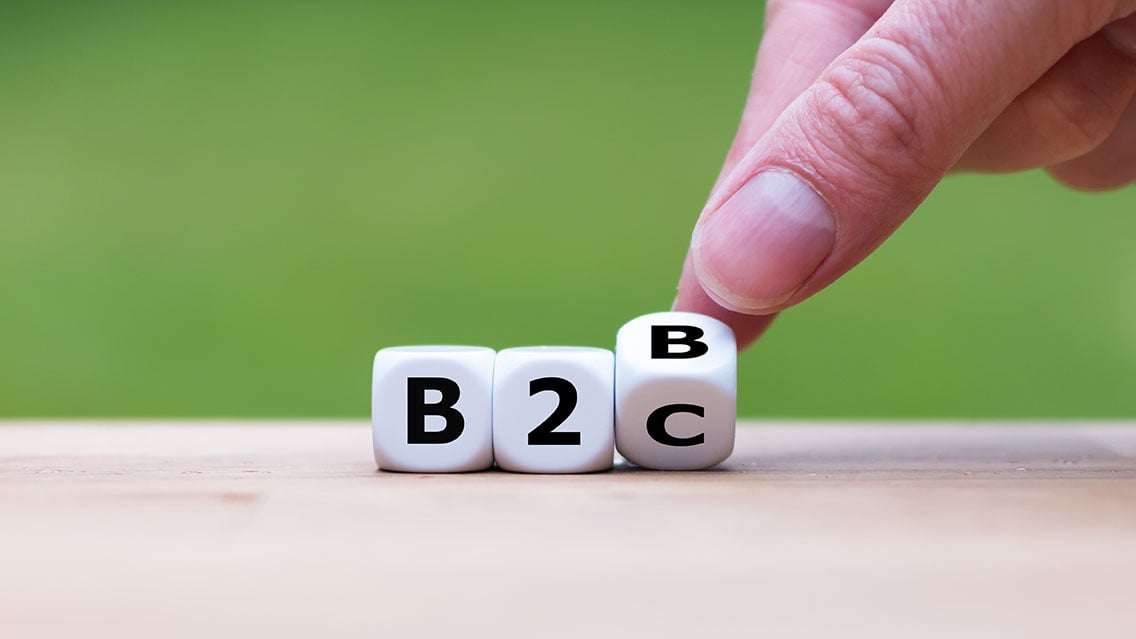
As marketing and sales professionals, we learned from a young age the difference between B2Bs and B2Cs. It’s marketing 101, right? They also know the importance of understanding the sales funnel as it pertains to their company and their target audience.
Many will argue that despite the fundamental difference between B2Bs and B2Cs, the sales funnels are the same.
At its core, consumers generally exhibit similar shopping behaviors, but there’s a reason why you have a target audience. There’s a reason why your company dedicates resources to conduct research on your ideal buyer.
It’s because B2B consumers and B2C consumers are, in fact, different. Their decision-making processes vary from one another.
Therefore, as marketing and sales professionals, it’s important to recognize that the sales cycle for B2Bs and B2Cs have distinct differences that drive varying strategies for converting new leads.
In this article, we’re going to do a deep dive into understanding the B2B and B2C sales funnels and how to convert and delight your consumers in each stage of their buyer’s journey.
What Is The Sales Funnel?
You’ve probably heard several different names for the sales funnel – purchase funnel, AIDA model, customer funnel, marketing funnel – it’s easy to get a little confused as to whether they’re all different or simply one and the same.
For the most part, they are all the same.
A sales funnel, whether it’s business-to-business (B2B) or business-to-customer (B2C), is a consumer-focused model that visually illustrates a customer’s journey from the first contact to the purchase of a product or service.
It’s an opportunity for your sales and marketing team to get into the mindset of your ideal buyer and identify how you’d like to move them through the sales funnel.
The sales funnel originated as the purchase funnel in 1898 by E. St. Elmo Lewis. His original model is still used in the marketing and sales world today, but naturally, it has been transformed to accommodate the changes of the modern consumer.
B2B Sales Funnel vs. B2C Sales Funnel Overview
Now, many might argue that the sales funnel for both B2Bs and B2Cs is the same. While there is an obvious overlap between the two, as a B2B business here at VMG Studios that supports both B2B and B2C clients, we’ve come to recognize there is a noticeable difference.
Here’s a quick snapshot of how the two vary.
| B2B | B2C | |
|
Sales Funnel Stages |
6 |
4 |
|
Sales Cycle Duration |
Longer |
Shorter |
|
Target Audience |
Group |
Individual |
|
Preferred Social Networking |
|
Facebook, Instagram, Twitter |
I’m sure you noticed the difference in the number of sales funnel stages. This is where we clearly see the defined difference between B2B and B2C. Sequentially, this attributes to a longer sales cycle for B2Bs versus B2Cs.
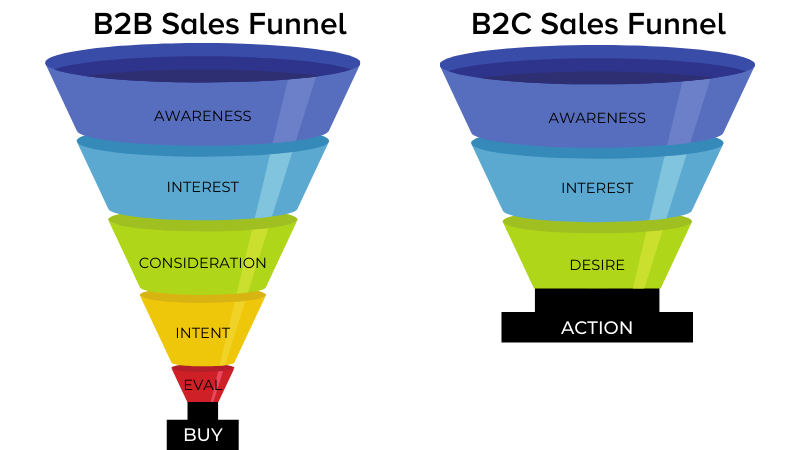
As you can see, both sales funnels begin with awareness and interest. From there, they branch off into various stages. We’re now going to take a closer look at each of the funnels and break down why B2Bs have more stages and a longer sales cycle compared to B2Cs.
Understanding the B2B Sales Funnel
B2Bs companies make transactions with other businesses and often sell and target a group rather than an individual consumer.
VMG Studios, for example, is a B2B company. We provide creative content for other businesses, specifically enterprise-level corporations. We use HubSpot as our CRM (customer relationship management), which is another example of a B2B business, as it sells its products to other businesses like VMG.
Typically, more people are involved in purchasing decisions within B2Bs, which leads to a longer sales cycle and more stages in the sales funnel.
Let’s take a look at the sales funnel once again but add in a little bit more context in regard to each stage.
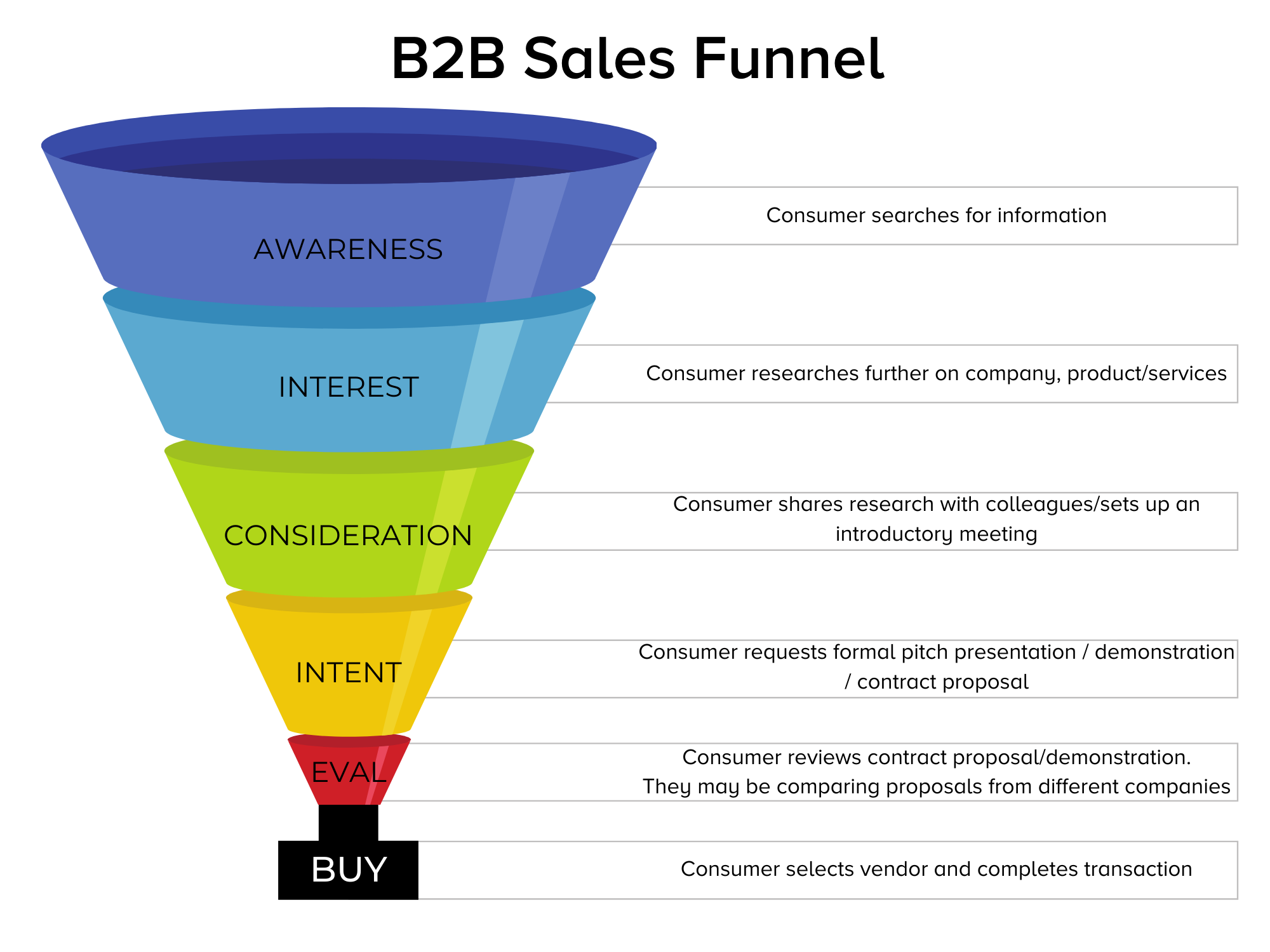
B2B Sales Funnel Stage 1: Awareness
The awareness stage is the first part of the buyer’s journey. The consumer is identifying a need or a problem that requires solving and they’re beginning the process of selecting the right product/service.
In general, it’s safe to assume that most buyers will either return to companies they’ve used before to solve a particular need or they’ll ask for referrals from friends, family members, or colleagues.
If that’s not the case, consumers will likely turn to Google to find a solution, and this is where content marketing can make a huge difference in new prospects finding your company.
Content marketing is a strategic inbound marketing approach focused on creating and distributing valuable, relevant, and educational content digitally to attract, retain, and qualify potential new leads.
If your company is able to rank on search engines, such as Google, for targeted keywords and phrases, you can drive awareness of your brand.
READ: Benefits of Content Marketing for B2Bs
B2B Sales Funnel Stage 2: Interest
The interest stage is when a consumer conducts a deeper audit of your company and product/services.
They’ll likely spend time on your website to get a better understanding of your service offerings. They’ll look at portfolio pieces, testimonials, and reviews. If your company invests in content marketing, they may look at more educational resources on your learning hub. They might even check out your social media channels.
Ultimately, if your website provides ample information about your brand, prospects can qualify themselves as a good fit before reaching out to a sales representative for an introductory meeting.
Did you know that the average person consumes 11 pieces of content before making a purchasing decision?
I’m sure you’d hope that a potential consumer would read 11 pieces of your content, as opposed to content from a competitor or outside source, which is another reason content marketing is a solid strategy to implement if you haven’t already.
B2B Sales Funnel Stage 3: Consideration
Now that a prospect knows more about your company including the services/products you provide, they’ll likely share their research with all key stakeholders on their team.
As mentioned, B2Bs generally have to sell to a group of people instead of an individual, which often leads to this longer sales cycle.
During the consideration stage, a prospect might conduct even further research into your company based on questions raised from colleagues or from competitive audits if the prospect is vetting two or more companies for a single job.
After doing some final research within the team, the first point of contact will likely happen. This could mean setting up an introductory meeting, video meet-and-greet, email follow-up, price quote request, or something equivalent.
B2B Sales Funnel Stage 4: Intent
Once that first initial meeting has happened, the prospect will request a follow-up. This could include a formal pitch presentation, a formal product demonstration, and/or a contract proposal.
At this stage, it’s becoming clear the prospect is more serious about converting thanks to the abundance of research and vetting that has been conducted to reach this point of the sales funnel.
This is where it’s time for the sales team to truly shine and take what they’ve learned about the potential client’s needs in the introductory meeting and showcase how your company is the best fit.
B2B Sales Funnel Stage 5: Evaluation
The evaluation stage is an important part of the consumer’s journey. It’s where the consumer will review all they’ve learned about your company and evaluate your pitch presentation and/or proposal.
If you’re the only company they’re considering, hopefully, you’ve provided enough to get them across the finish line. If you’re not the only company, they’ll use this time to evaluate your pitch and proposal against your competitors.
This is why it’s important to be aware of your competitors and establish ways to differentiate your company from them, which is also part of the process of successfully building or revamping your brand.
B2B Sales Funnel Stage 6: Buy
You’ve finally made it! After all the research, vetting, and evaluating, the consumer has decided to purchase your product or service.
At this point, contracts will be signed (if applicable, of course) and the transaction is completed.
While the sales funnel technically ends in the “buy” stage, we argue the work truly never stops. Once you’ve successfully guided someone through the sales funnel, there are follow-up stages to consider retaining this consumer’s business.
This includes delivering on the promised transaction, of course, but also building a lasting relationship through exceptional work, accountability, transparency, and strong communication to ensure this consumer becomes a loyal client.
Understanding the B2C Sales Funnel
B2C generally targets the individual consumer, which streamlines the sales funnel, slightly. Depending on the product or service you’re offering, the sales cycle can be as short as 5 minutes (hello, online shopping!) and doesn’t require a salesperson to finalize a transaction. However, a B2C sales funnel still starts in the same stage as a B2Bs.
Most consumers still research before they buy. This is especially evident in any big brand showdown of similar products.
Take fitness trackers, for example. There are different kinds of fitness trackers from various companies with varying features and price points. If you’re interested in purchasing one, you’ll likely do research ahead of time to ensure you’re making a logical purchase based on your needs and budget. (And as someone who didn’t research ahead of time and has since tried a Nike Fuel Band, Fitbit, and Apple Watch, I wish I could go back in time and tell my younger stuff to do some research).
Just like we did for the B2B sales funnel, let’s now take a closer look at the 4 stages of the B2C sales funnel.
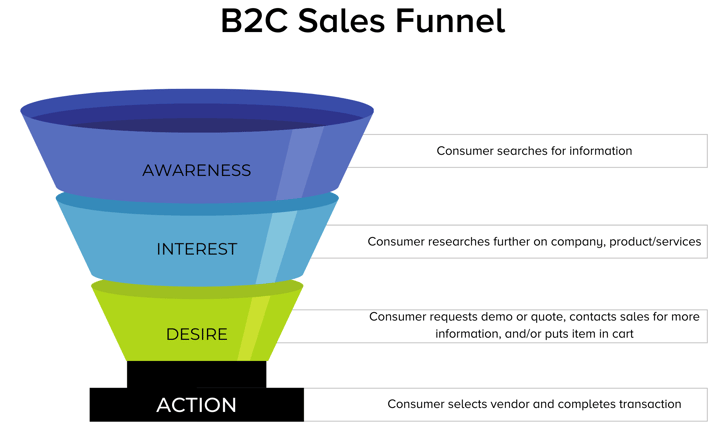
B2C Sales Funnel Stage 1: Awareness
As mentioned, the B2C sales funnel follows the same initial trajectory as the B2B sales funnel and begins with the awareness stage.
In general, B2Cs benefit more than B2Bs from traditional marketing and advertising strategies such as paid media (TV/streaming and radio commercials, paid social campaigns, etc.), which can help increase brand awareness.
Besides this, B2Cs may also attract new potential clients through referrals and/or content marketing.
B2C Sales Funnel Stage 2: Interest
I’m going to sound a bit like a broken record here, but this stage is also similar to the B2B sales funnel.
Further research is conducted here whether it’s information provided on your website to a deeper dive of your products and/or services including reviews to comparing your company to your competitors.
Once again, this is where educational resources such as articles, videos, eBooks, or infographics (AKA content marketing) can really help set your company apart from a competitor.
FREE DOWNLOAD: Content Marketing 101 Worksheet
B2C Sales Funnel Stage 3: Desire
Have you ever researched a product extensively and quickly turned to an “I must have this” mindset?
If so, you’re definitely not alone.
With an effective marketing strategy such as product videos, educational resources, price guides, social media campaigns, etc. the hope is that a consumer will be excited and confident to convert.
This stage can mean a couple of different things depending on a company’s product or service offering. They might reach out for a demonstration, request a quote, fill out a form for more information or talk to a sales representative. Or, they might just go ahead and add the product/service to their cart.
For B2Cs, this stage will also include some evaluation, but likely not as in-depth of an analysis as the B2B version. The evaluation may be as simple as doing a quick scan at the product details (price and delivery details, for example) in your cart before hitting submit.
B2C Sales Funnel Stage 4: Action
This stage is self-explanatory, but this is the time you celebrate a completed transaction. A purchase has been made. The consumer’s cart is empty, and their product is on the way.
To reiterate, the relationship shouldn’t stop here. If they are happy with your product or service, encourage them to leave a review. Ask them to sign up for email updates for future product announcements, launches, and sales. Facilitate that relationship that took time and resources to craft into a repeat buyer.
How the B2B and B2C Sales Funnels Are Different
Understanding your target audience, specifically how they decide to spend their money and the problems they’re looking to solve is an important part of any successful sales and marketing strategy.
Being able to segment the consumer’s purchasing funnel based on your service types, such as B2B or B2C can help drill down your sales cycle and strategically plan for how to engage and assist a prospect in each stage.
Leveraging the B2B or B2C buyer’s journey for specific campaigns, as well, such as before a product launch, allows the sales and marketing team to think strategically about the buyer’s experience in each stage and track specific metrics. This can help identify parts of the strategy that maybe aren’t performing well and pivot quickly and accordingly to ensure you’re maximizing your marketing dollars.
Fundamentally, there are many similarities between a B2B sales funnel and a B2C sales funnel, however, there are noticeable differences that require specific, deliberate planning.

Those first two stages, awareness and interest, are important in attracting new prospects, and this is where content marketing can help fill any void when it comes to a lack of awareness or slow website traffic. Educating your clients about the services you provide can establish thought leadership and build trust, which often helps funnel customers through the sales cycle.
Like any business, VMG Studios has adapted our own strategy with the goal of consistently attracting and retaining clients. We’ve found what works for us as a B2B and have also seen how the B2C sales funnel has shifted with many of our clients due to the rise of digital marketing and online shopping.
If you’re in need of a revamping of your marketing strategy, whether it’s video content, content marketing, or a brand refresh, we’re here to help you find your ideal buyer and not only gain their business but retain it.
Start planning your next project today by downloading our free creative messaging brief!



